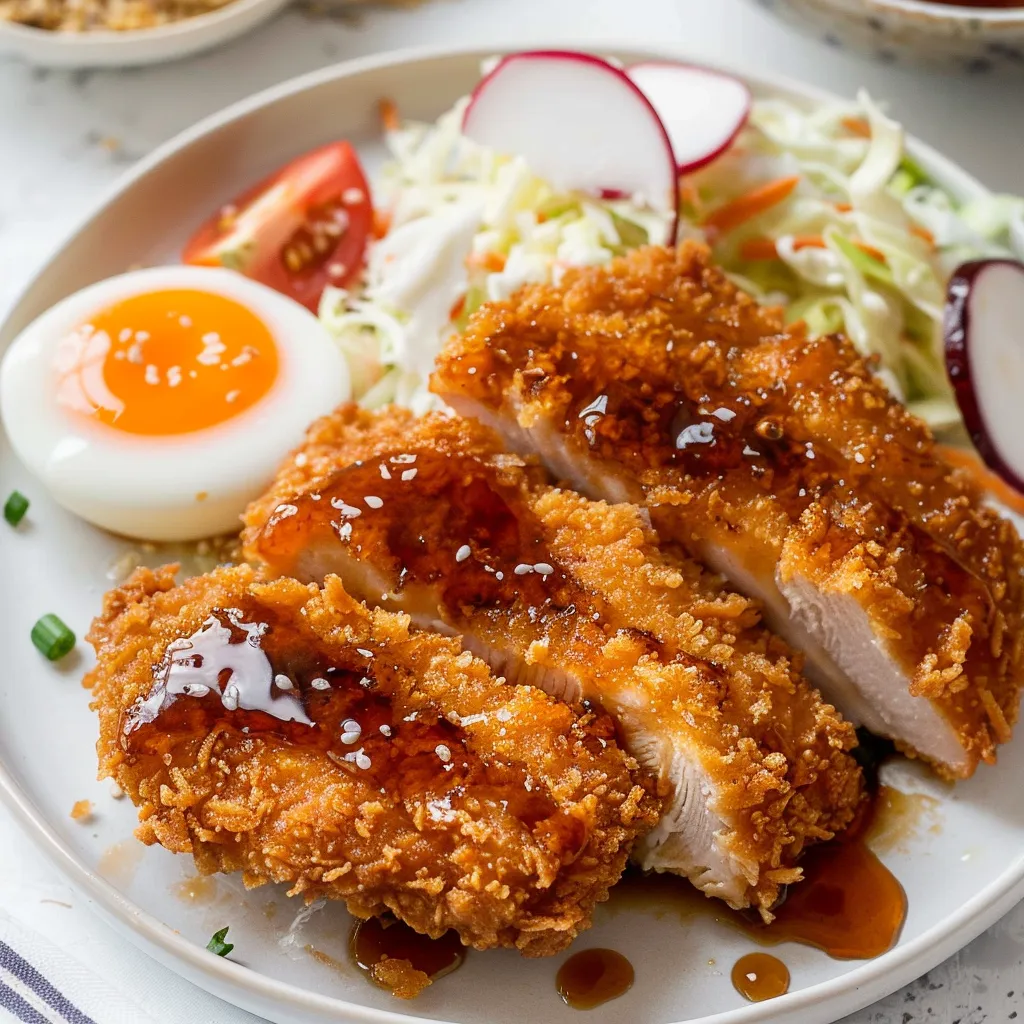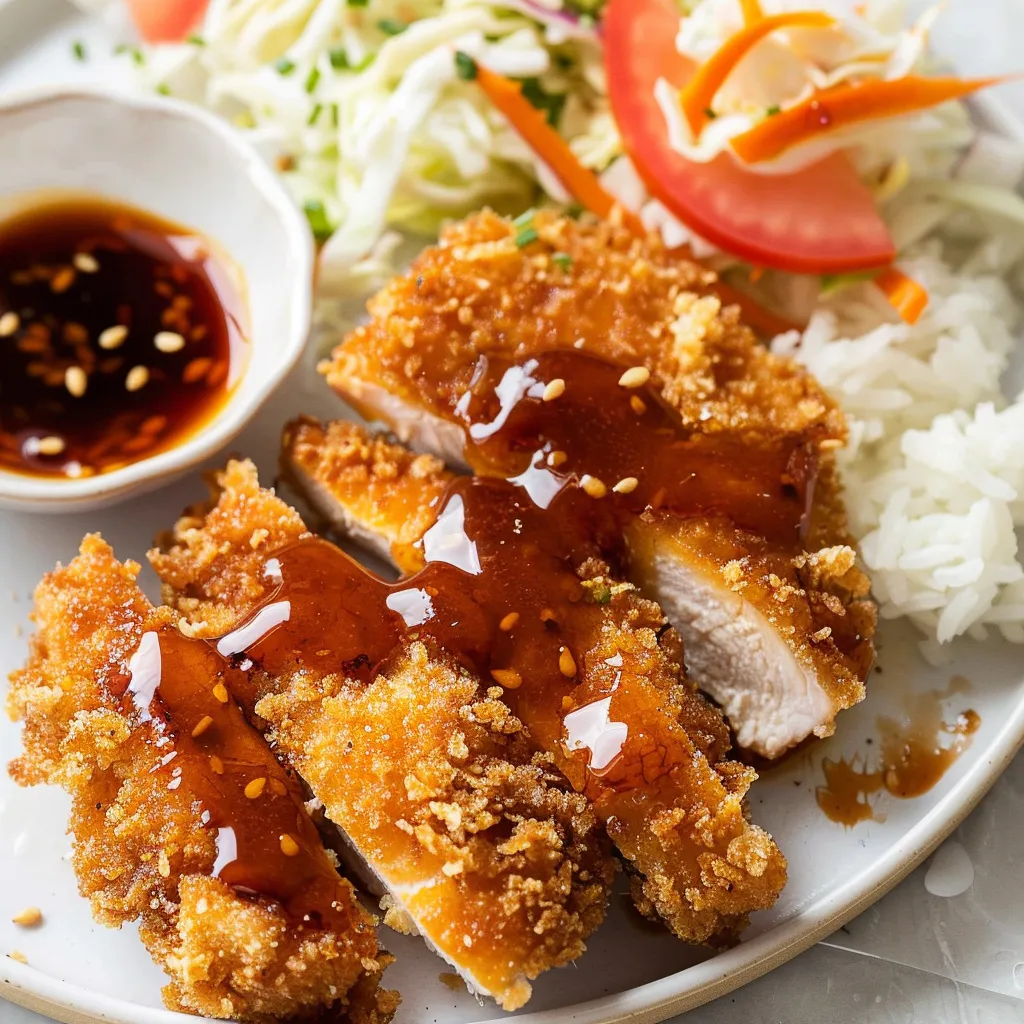 Pin it
Pin it
Nothing beats the ultimate Japanese comfort food - that golden, super-crunchy chicken katsu. This fan-favorite transforms ordinary chicken breasts into something magical with its light, crackling panko shell and moist, tender inside. Each mouthful gives you that awesome crunch that's made this dish a hit with everyone at my home.
I've been making chicken katsu for so long now, it's become my number one choice when friends come for dinner. My kids get all excited whenever they hear it's katsu night, and even my super-picky nephew always wants more.
Key Ingredients
- Boneless chicken breasts: Try to get ones that are about the same thickness so they cook evenly. I think organic chicken tastes better and has a nicer texture
- Japanese panko breadcrumbs: These fluffy, light crumbs are what give you that amazing crunch. Regular breadcrumbs just won't work the same
- Neutral vegetable oil: Go for something that can handle high heat to get that beautiful golden coating without any burnt flavor
 Pin it
Pin it
Simple Cooking Steps
- Step 1: Get Your Chicken Ready
- - Lay chicken between plastic wrap, pushing out any air bubbles
- Pound it until it's all the same thickness, being careful not to tear it
- Add salt and pepper while the chicken sits at room temp - Step 2: Set Up Your Coating
- - Arrange your stations in this order: flour, whisked eggs, then panko
- Use your left hand for dry stuff and right hand for wet to keep things clean
- Push the panko onto the chicken firmly so it sticks well - Step 3: Nail the Frying
- - Get your oil to just the right heat (350°F) for that perfect golden color
- You should hear a soft sizzle when chicken touches the oil
- Keep the temperature steady while cooking so it browns evenly
 Pin it
Pin it
We found out that eating katsu right from the pan while standing around the kitchen makes the best memories. Everyone gets excited waiting for that first crunchy bite.
Mastering Oil Temperature
Getting the oil just right is super important for amazing katsu. If it's too hot, the outside burns before the chicken cooks inside. Too cool and your coating soaks up oil and gets soggy. I've learned to listen for that soft sizzle and watch the bubbles around the chicken - they should be steady but not crazy.
Tasty Dipping Options
The classic tonkatsu sauce is great, but trying different dips can make this dish even better. My homemade curry sauce has become a family hit, making simple katsu into a complete meal. Even just squeezing fresh lemon juice on top adds a bright, zingy flavor that cuts through the richness.
Personal Touches
After making katsu for years, I've found little changes can make it fit your taste perfectly. Try adding a bit of garlic powder to the flour or mixing in some sesame seeds with the panko for subtle but yummy differences. Some nights, I slice it up for sandwiches with shredded cabbage and sauce.
How We Enjoy It
At our house, we always put a big pile of thinly sliced cabbage next to the katsu, along with steamed rice and miso soup. The fresh cabbage balances out the crunchy chicken perfectly, and the rice soaks up all the tasty sauce. It's become our end-of-week tradition, bringing everyone to the table every Sunday.
Keeping Leftovers
Katsu tastes best fresh off the pan, but you can save it right too. I've found putting it on a wire rack in the fridge helps keep the coating from getting soggy. A quick warm-up in a hot oven brings back a lot of that original crunch.
 Pin it
Pin it
Perfect Breading Secrets
The trick to amazing katsu coating is all about how you handle wet and dry stuff. I learned through lots of tries that a light coating of flour, then just enough egg, makes the best base. The panko should be pressed on gently but firmly, so each crumb can create its own tiny crispy bit when fried. It took me forever to get this just right, but now watching that coating turn golden brown makes me happy every time.
Planning Ahead
Katsu has become a key part of how I plan our meals. I often fix extra chicken pieces on Sunday and freeze them before adding the coating. This means I can quickly make a fresh batch during busy weeknights. The flattened, uncooked chicken stays good in the freezer for up to three months, making spur-of-the-moment katsu nights super easy.
The Story Behind It
Every time I cook katsu, I think about its cool background. This dish shows how Japanese cooking precision mixed with Western ideas. My Japanese neighbor told me how her grandma would make katsu for special days, serving it with carefully chosen sides that went perfectly with both the texture and taste. Learning these things has made me appreciate this simple-looking dish even more.
Creating a Full Dinner
The best thing about chicken katsu goes beyond just the main dish. I always serve it with quick-pickled cucumbers that add a cool crunch and clean your palate between bites. A small miso soup helps balance out the richness, while some steamed edamame makes a protein-packed starter that keeps hunger at bay while the katsu cooks.
Tools That Help
Having the right stuff really helps when making katsu. A heavy pan gives you even heat, while a good meat pounder helps get that important same thickness throughout. I keep special long cooking chopsticks just for frying - they let me flip the chicken with more control and don't damage the coating like tongs might.
Cooking With Kids
Making katsu has turned into a favorite cooking lesson in our family. The easy steps are great for teaching kids kitchen skills, from adding seasoning to safe frying methods. My daughter now proudly makes her own version, adding her special touch by sprinkling furikake on top when it's done. These cooking times create wonderful memories while passing down food traditions.
Adjusting for Special Diets
Over time, I've changed this recipe for different dietary needs. For gluten-free friends, rice flour and gluten-free panko work great for crunchiness. When cooking for people watching their oil intake, I've come up with an oven-baked version that's different but still tasty. The key is keeping what makes katsu special while swapping ingredients thoughtfully.
Wrapping Up
After making this dish countless times, I still get excited when I hear that first sizzle as the coated chicken hits hot oil. Chicken katsu means more than just food in our home - it's about skill, tradition, and being together. Whether you're making it for the first time or you've lost count, each batch brings its own kind of joy.
Frequently Asked Questions
- → Why flatten the chicken?
- It helps it cook evenly and stay tender.
- → Can I swap out panko?
- Regular crumbs will work, but panko is crunchier.
- → How can I check oil temperature?
- Drop in a crumb—it should sizzle on contact without burning.
- → Is baking an option?
- Yep! Bake at 400°F for about 25 minutes for a lighter version.
- → What exactly is tonkatsu sauce?
- It's a Worcestershire-style Japanese sauce with a sweet and savory kick, found in Asian stores.
